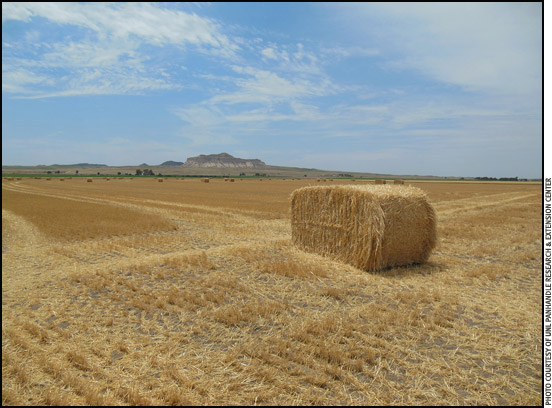
Forage Following Winter Wheat
What are the options and production costs?
Drought in western Nebraska has strained rangeland and other forage production. For some wheat producers, this is a unique opportunity for additional income.
Area cattle producers are creating demand for reasonably priced forage, as alfalfa prices reach and exceed $180 per ton in western Nebraska. Wheat growers might consider two postharvest options for meeting some of this demand: baling wheat straw and planting an additional forage crop.
Baling wheat straw
Most wheat producers can bale their wheat straw. The dilemma for dryland producers is that residue retention has become an important part of their reduced- or no-till cropping system. Although economically enticing, the drawbacks to removing this straw include loss of nutrients and less moisture retention because of less crop residue.
However, some wheat dryland farmers are baling part of their straw, leaving about 12 inches of stubble to serve as a cover for the upcoming year. On 40-bushel (bu.) dryland wheat, producers could harvest an estimated 1 ton of straw per acre, or less for semi-dwarf varieties. The cash cost would be approximately $16 per ton.
For irrigated wheat producers, straw removal is a good option. Straw production can be calculated fairly accurately from grain yield. The Harvest Index (ratio of grain to total dry matter) for most semi-dwarf wheat varieties in western Nebraska is about 0.3. An 80-bu. wheat crop will produce more than 5 tons of straw per acre. Baling the straw will have a cash cost of approximately $10 per ton in the Panhandle.
The decision to remove wheat residue should be balanced with the agronomic needs of your operation. Wheat straw should prove valuable to local livestock operations and will bring a decent price at market, especially if drought conditions continue. However, this practice may not be worth the additional cash flow if removing this residue will affect future production.
Following wheat with a forage crop
Drought has created the demand, and early wheat harvest has created the opportunity, for wheat producers to plant a forage crop into recently harvested fields. This choice has several benefits, but also should be weighed against costs.
In the Panhandle, some producers are already making efforts to include an additional forage crop, taking advantage of high forage prices or needs of their own livestock. Adding an additional crop, such as forage millet or sorghum-Sudan, can be beneficial for producers if they have sufficient water.
Harvesting straw and producing forage millet following irrigated wheat will have a cash cost to producers of approximately $89.03 per ton in a traditional tillage system, using pivot irrigation in the Panhandle. Four budgets for this practice have been produced to estimate the costs of including an additional crop.
For tilled systems, sorghum-Sudan provides the lowest cash cost per ton at $71.92. At $55.23 and $46.57 cash cost per ton, respectively, comparison between forage millet and sorghum-Sudan is very close for no-till systems.
Of course several considerations should be taken into account when approaching the decision to proceed with an additional forage crop this year. However, such costs may easily be covered by the two forage crop options under this budget: wheat straw and millet or sorghum-Sudan.
One limiting factor may be availability of suitable seed. Dryness in the southern United States reduced millet seed production last year, and increased demand for forage has contributed to limited forage seed availability. Additionally, producers will need to evaluate their marketing channels for the additional forage once harvested and equipment availability.
Although it has been an unusual year for wheat producers, it has provided some unique opportunities for additional income. As always, it is important to balance the economic goals of your operation with the agronomic needs of your farm.
Budget tables with detailed cost information for all these options are available at the UNL Panhandle Research and Extension Center's website. Browse to panhandle.unl.edu and click on the link that says "Drought Resources."
If you have questions regarding the budgets, please contact Gary Hergert, soil and nutrient management specialist, at 308-632-1372 or email him; or Jessica Johnson, agricultural economics assistant extension educator, at 308-632-1247 or email her.











 by Jessica Johnson & Gary Hergert
by Jessica Johnson & Gary Hergert